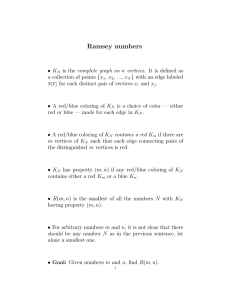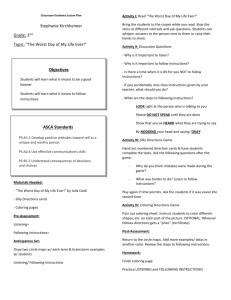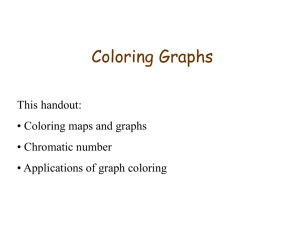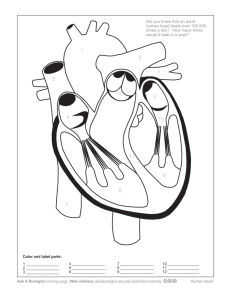Evaluating Graph Coloring on GPUs
advertisement
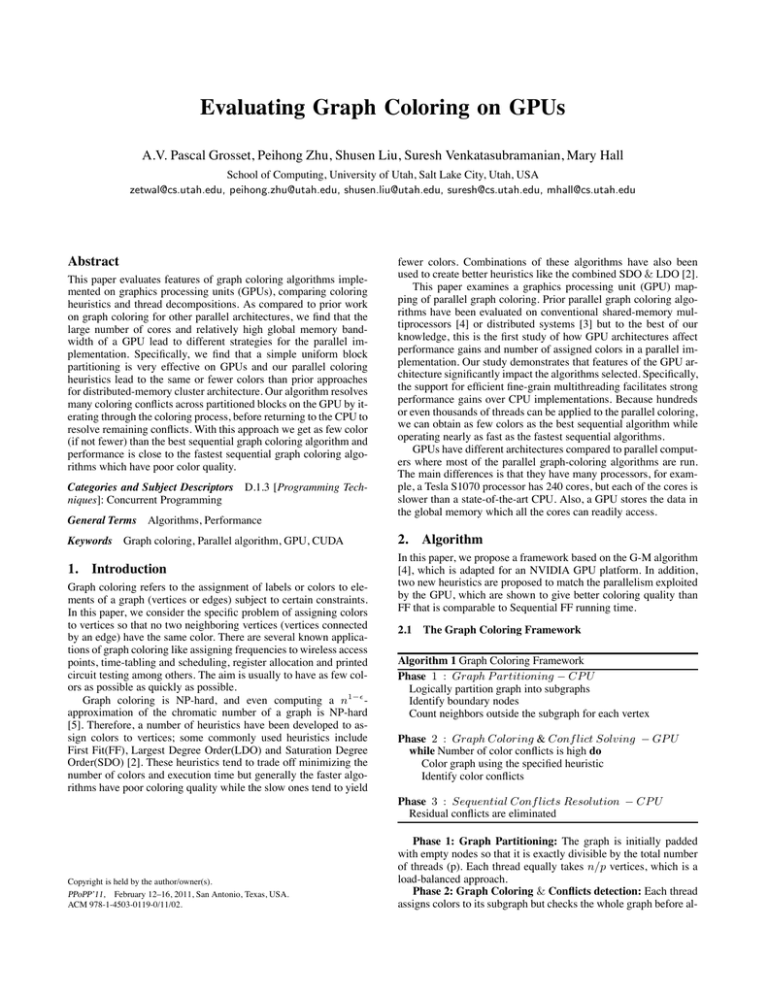
Evaluating Graph Coloring on GPUs A.V. Pascal Grosset, Peihong Zhu, Shusen Liu, Suresh Venkatasubramanian, Mary Hall School of Computing, University of Utah, Salt Lake City, Utah, USA zetwal@cs.utah.edu, peihong.zhu@utah.edu, shusen.liu@utah.edu, suresh@cs.utah.edu, mhall@cs.utah.edu Abstract This paper evaluates features of graph coloring algorithms implemented on graphics processing units (GPUs), comparing coloring heuristics and thread decompositions. As compared to prior work on graph coloring for other parallel architectures, we find that the large number of cores and relatively high global memory bandwidth of a GPU lead to different strategies for the parallel implementation. Specifically, we find that a simple uniform block partitioning is very effective on GPUs and our parallel coloring heuristics lead to the same or fewer colors than prior approaches for distributed-memory cluster architecture. Our algorithm resolves many coloring conflicts across partitioned blocks on the GPU by iterating through the coloring process, before returning to the CPU to resolve remaining conflicts. With this approach we get as few color (if not fewer) than the best sequential graph coloring algorithm and performance is close to the fastest sequential graph coloring algorithms which have poor color quality. Categories and Subject Descriptors niques]: Concurrent Programming General Terms Keywords D.1.3 [Programming Tech- Algorithms, Performance Graph coloring, Parallel algorithm, GPU, CUDA 1. Introduction Graph coloring refers to the assignment of labels or colors to elements of a graph (vertices or edges) subject to certain constraints. In this paper, we consider the specific problem of assigning colors to vertices so that no two neighboring vertices (vertices connected by an edge) have the same color. There are several known applications of graph coloring like assigning frequencies to wireless access points, time-tabling and scheduling, register allocation and printed circuit testing among others. The aim is usually to have as few colors as possible as quickly as possible. Graph coloring is NP-hard, and even computing a n1− approximation of the chromatic number of a graph is NP-hard [5]. Therefore, a number of heuristics have been developed to assign colors to vertices; some commonly used heuristics include First Fit(FF), Largest Degree Order(LDO) and Saturation Degree Order(SDO) [2]. These heuristics tend to trade off minimizing the number of colors and execution time but generally the faster algorithms have poor coloring quality while the slow ones tend to yield fewer colors. Combinations of these algorithms have also been used to create better heuristics like the combined SDO & LDO [2]. This paper examines a graphics processing unit (GPU) mapping of parallel graph coloring. Prior parallel graph coloring algorithms have been evaluated on conventional shared-memory multiprocessors [4] or distributed systems [3] but to the best of our knowledge, this is the first study of how GPU architectures affect performance gains and number of assigned colors in a parallel implementation. Our study demonstrates that features of the GPU architecture significantly impact the algorithms selected. Specifically, the support for efficient fine-grain multithreading facilitates strong performance gains over CPU implementations. Because hundreds or even thousands of threads can be applied to the parallel coloring, we can obtain as few colors as the best sequential algorithm while operating nearly as fast as the fastest sequential algorithms. GPUs have different architectures compared to parallel computers where most of the parallel graph-coloring algorithms are run. The main differences is that they have many processors, for example, a Tesla S1070 processor has 240 cores, but each of the cores is slower than a state-of-the-art CPU. Also, a GPU stores the data in the global memory which all the cores can readily access. 2. Algorithm In this paper, we propose a framework based on the G-M algorithm [4], which is adapted for an NVIDIA GPU platform. In addition, two new heuristics are proposed to match the parallelism exploited by the GPU, which are shown to give better coloring quality than FF that is comparable to Sequential FF running time. 2.1 The Graph Coloring Framework Algorithm 1 Graph Coloring Framework Phase 1 : Graph P artitioning − CP U Logically partition graph into subgraphs Identify boundary nodes Count neighbors outside the subgraph for each vertex Phase 2 : Graph Coloring & Conf lict Solving − GP U while Number of color conflicts is high do Color graph using the specified heuristic Identify color conflicts Phase 3 : Sequential Conf licts Resolution − CP U Residual conflicts are eliminated Copyright is held by the author/owner(s). PPoPP’11, February 12–16, 2011, San Antonio, Texas, USA. ACM 978-1-4503-0119-0/11/02. Phase 1: Graph Partitioning: The graph is initially padded with empty nodes so that it is exactly divisible by the total number of threads (p). Each thread equally takes n/p vertices, which is a load-balanced approach. Phase 2: Graph Coloring & Conflicts detection: Each thread assigns colors to its subgraph but checks the whole graph before al- Figure 1. First row: Average Colors vs Threads (Subgraph size) - Second row: Value below each bar shows the best average color and their matching time is indicated on the y-axis. locating colors. We tried four heuristics including two new heuristics (MAX OUT and MIN OUT) for color allocation: i) First Fit: Allocate the smallest possible color to each vertex no specific criteria is used to choose which vertex to color first. ii) SDO & LDO: Color is allocated to the vertex having the highest saturation and then highest degree. iii) MAX OUT: Color is allocated to the vertex having most neighbors out of the subgraph and then highest degree. iv) MIN OUT: Color is allocated to the vertex having fewest neighbors out of the subgraph and then highest degree. Conflicts occurring between vertices in different subgraphs are identified by assigning one thread per boundary node which checks for color conflicts and reset the color of these nodes to null. Phase 3: Sequential Conflicts Resolution Dropping to the CPU to solve the conflicts is common in many approaches but given that we have many small partitions, we tend to have lots of conflicts and resolving that on the CPU can be quite slow. So we do multiple passes of step 2 on GPU until the number of conflicts become very small and can be quickly solved sequentially on the CPU. 3. Experiments and Results The algorithm has been implemented using the CUDA API and the tests were carried out on a Tesla S1070 with real graphs from the University of Florida Sparse Matrix Collection[1]. In this paper we will focus on 3 different graphs shown in Table 1. Name hood pkustk10 pwtk n 220,542 81,920 217,918 m 5,273,947 2,114,154 5,926,171 Δ 76 89 179 FF 42 42 57 Colors SDO & LDO 36 42 48 Time(ms) FF 104 39 48 Table 1. Graph properties and sequential coloring baselines: nnumber of vertices, m -number of edges, Δ- max degree. To investigate the impact of parallel graph coloring algorithms on both performance and number of colors obtained, the number of threads is linearly incremented and the timing and color obtained is compared and the results are shown in Figure 1. The results (average of 10 runs) show that MAX and MIN generally yield fewer colors and we also notice that good coloration is obtained at relatively small subgraph sizes. For pwtk, coloring gets worse at subgraph sizes of around 9. We believe that this is due to unfortunate partitioning as if the vertices are shuffled and then colored, we do not see that peak. [2] explains why SDO & LDO is better than FF. MAX and MIN substitute choice based on saturation for SDO & LDO for vertices in or out of the subgraph. This favors vertices which have more connection to the other vertices. In terms of speed among the parallel graph coloring algorithms, First Fit is the fastest followed by SDO & LDO, MIN and MAX which take roughly the same amount of time. MIN and MAX are at least twice as slow as they require twice as much memory access compared to SDO & LDO. The best combination of good coloring and high performance is given by Parallel SDO & LDO; its running time is within a factor of 2 of sequential First Fit. 4. Conclusion The proposed GPU implementation provides much better coloring quality in terms of number of colors used, and the running time is comparable to sequential FF (known as the fastest sequential coloring algorithm). Running on GPU introduces overheads but the hundreds of cores allows for extreme parallelism and the nondeterminism makes initial bad choices less damaging allowing Parallel First Fit to give better colors than the Sequential one. In many cases, it can even beat colors reported in [3]. References [1] The university of florida sparse matrix collection. URL http://www.cise.ufl.edu/research/sparse/matrices/. [2] H. Al-Omari and K. Sabri. New graph coloring algorithms. Am. J. Math. & Stat, 2(4):739–741, 2006. [3] A. M. F. B. E. C. Bozdag, D Gebremedhin. A framework for scalable greedy coloring on distributed-memory parallel computers. Journal of Parallel and Distributed Computing, 68(4):515–535, 2008. [4] A. Gebremedhin and F. Manne. Scalable parallel graph coloring algorithms. Concurrency: Practice and Experience, 12(12):1131–1146, 2000. [5] D. Zuckerman. Linear degree extractors and the inapproximability of max clique and chromatic number. Theory of Computing, 3(1):103–128, 2007. doi: 10.4086/toc.2007.v003a006. URL http://www.theoryofcomputing.org/articles/v003a006.

